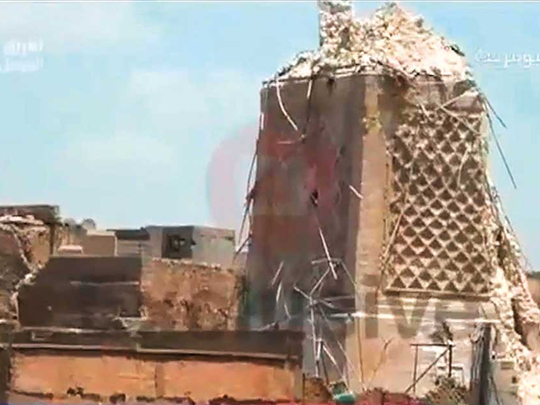
Mosul/Baghdad: “When I looked out of the window and saw the minaret was no longer there, I felt a part of me had died.” For Ahmad Saied, a 54-year-old Iraqi schoolteacher, and many others Mosul can never be the the leaning minaret that had graced his city for nearly 850 years was destroyed.
In the dawn light, all that remained was the base projecting from shattered masonry.
The destruction came as Iraqi forces closed on the mosque, which also carried enormous symbolic importance for Daesh whose leader Abu Bakr Al Baghdadi used it in 2014 to declare a so-called “caliphate” spanning swathes of of Syria and Iraq.
His black flag had been flying on the 45-metre minaret since June 2014, after Daesh fighters surged across Iraq, seizing vast swathes of territory.
“In the early morning, I climbed up to my house roof and was stunned to see Al Hadba minaret had gone,” Nashwan, a day- labourer living in Khazraj neighborhood near the mosque, said by phone.
“I broke into tears. I felt I had lost a son of mine.” The minaret was built with seven bands of decorative brickwork in complex geometric patterns also found in Persia and Central Asia. Its tilt and the lack of maintenance made it particularly vulnerable to blasts.
The mosque’s military and religious history embodies the spirit of Mosul, a conservative city which supplied the armed forces with officers since modern Iraq was created, about 100 years ago.
The Mosque’s destruction occurred during the holiest period of the Islamic holy month of Ramadan, its final 10 days. The night of Laylat Al Qadr falls during this period, marking when Muslims believe the Quran was revealed to the Prophet Mohammed (PBUH).
Daesh fighters have destroyed many Muslim religious sites, churches and shrines, as well as ancient Assyrian and Roman-era sites in Iraq and in Syria.
“Many different enemies controlled Mosul over the past 900 years but none of them dared to destroy Al Hadba.” said Ziad, an arts students.
“By bombing the minaret, they proved the are the worst of all barbarian groups in history.”
The media office for Iraq’s military distributed a picture taken from the air that showed the mosque and minaret largely reduced to rubble among the small houses and narrow alleys of the Old City. A video on social media showed the minaret collapsing vertically, throwing up a pall of sand and dust.
“The Iraqi security forces are continuing to push into remaining Daesh-held territory,” said US Army Colonel Ryan Dillon, spokesman for the US-led international coalition assisting in the Iraqi effort to defeat Daesh.
“There are two square kilometers left in West Mosul before the entire city is liberated,” he told Reuters by phone.
For many, the destruction of the minaret marked the final collapse of Daesh rule in Mosul and augured its demise across Iraq.
The fall of Mosul would in effect mark the end of the Iraqi half of the “caliphate”, though Daesh would still hold territory west and south of the city.
US-backed militias are closing on Daesh’s Syrian stronghold of Raqqa.
Al Baghdadi has left the fighting in Mosul to local commanders and is believed to be hiding in the border area between Iraq and Syria, according to US and Iraqi military sources.












